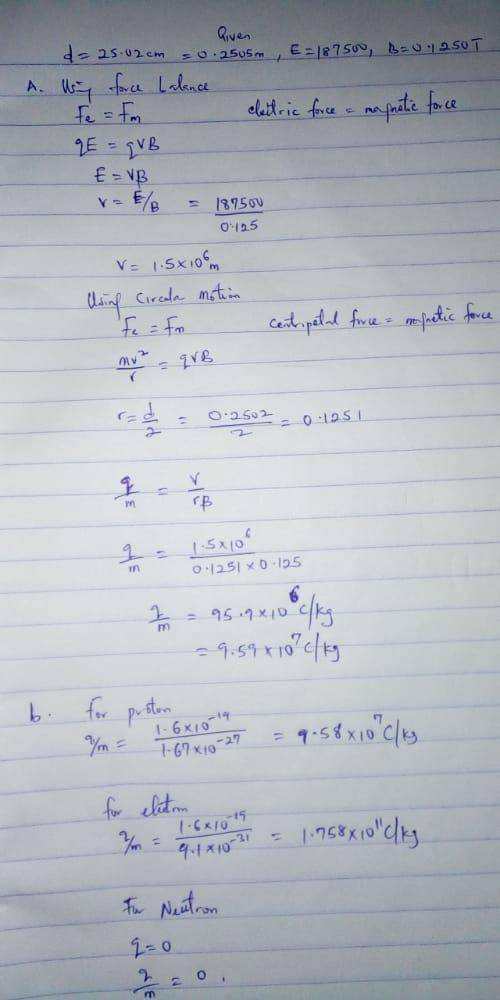
1. An unknown charged particle passes without deflection through crossed electric and magnetic fields of strengths 187,500 V/m and 0.1250 T, respectively. The particle passes out of the electric field, but the magnetic field continues, and the particle makes a semicircle of diameter 25.05 cm.
Part A. What is the particle's charge-to-mass ratio?
Part B. Can you identify the particle?
a. can't identify
b. proton
c. electron
d. neutron
2. A neutral lithium atom has three electrons. Two of these electrons form an "inner core," but the third-the valence electron-orbits at a much larger radius. From the valence electron's perspective, it is orbiting a spherical ball of charge having net charge +1e (i. e., the three protons in the nucleus and the two inner-core electrons). The energy required to ionize a lithium atom is 5.14 eV. Hint: Consider the energy needed to remove the electron and the force needed to give the electron a circular orbit.
Part A. According to Rutherford's nuclear model of the atom, what is the orbital radius of the valence electron? Express your answer with the appropriate units.
Part B. According to Rutherford's nuclear model of the atom, what is the speed of the valence electron? Express your answer with the appropriate units.

Answers: 1
Another question on Physics

Physics, 21.06.2019 22:00
What type of light does this light bulb produce most (i.e. at what wavelength does the spectrum have maximum intensity)?
Answers: 3

Physics, 22.06.2019 01:30
Use the frequency histogram to complete the following parts. ​(a) identify the class with the​ greatest, and the class with the​ least, relative frequency. ​(b) estimate the greatest and least relative frequencies. ​(c) describe any patterns with the data. female fibula lengths 30.5 31.5 32.5 33.5 34.5 35.5 36.5 37.5 38.5 39.5 0 0.05 0.1 0.15 0.2 0.25 length (in centimeters) relative frequency a histogram titled "female fibula lengths" has a horizontal axis labeled "length in centimeters" from 30.5 to 39.5 in increments of 1 and a vertical axis labeled "relative frequency" from 0 to 0.25 in increments of 0.05. the histogram contains vertical bars of width 1, where one vertical bar is centered over each of the horizontal axis tick marks. the approximate heights of the vertical bars are listed as follows, where the label is listed first and the approximate height is listed second: 30.5, 0.02; 31.5, 0.04; 32.5, 0.05; 33.5, 0.13; 34.5, 0.22; 35.5, 0.25; 36.5, 0.13; 37.5, 0.06; 38.5, 0.09; 39.5, 0.01. ​(a) the class with the greatest relative frequency is nothing to nothing centimeters. ​(type integers or decimals. do not round. use ascending​ order.)
Answers: 3

Physics, 22.06.2019 02:30
The act of moving from one place to another. a. locomotor b. aerobic c. stationary d. static
Answers: 3

Physics, 22.06.2019 04:20
Astone is thrown into a pond. what happens to the amplitude of the resulting waves as they get farther from the point where the stone hit the water? explain.
Answers: 3
You know the right answer?
1. An unknown charged particle passes without deflection through crossed electric and magnetic field...
Questions












Business, 24.12.2019 01:31




Physics, 24.12.2019 01:31


Physics, 24.12.2019 01:31

Social Studies, 24.12.2019 01:31

Health, 24.12.2019 01:31




